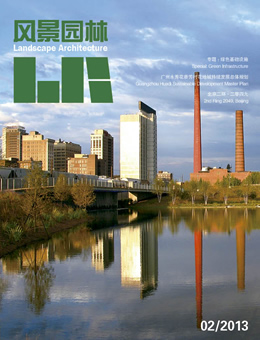The Study on Green Sponge Ecological Stormwater Storage & Treatment System in Rapid Urbanization Area
以辽宁康平卧龙湖生态保护区为例
A Case Study of Wolong Lake Area of Kangping, Liaoning
王云才 崔莹 彭震伟
WANG Yun-cai CUI Ying PENG Zhen-wei
摘要:卧龙湖生态保护区是以卧龙湖自然保护区为中心,深度受到城镇扩张、工业猛增和农业生产影响的地区,综合体现出水量减少,河流水网遭破坏,分散坑塘广布,区域汇水能力下降;城镇建设与湖区生态环境缺乏良性互动,对湖区干扰和污染较大;区域廊道系统网络化程度较低,且网络复合度低,功能单一等生态问题,其中水源急剧减少和水质恶化成为制约卧龙湖生态保护区健康发展的关键因素。立足于解决卧龙湖地区水源和水质问题, 在区域生态格局研究的基础上,通过多功能复合的区域廊道网络与水收集系统、城镇乡村绿色海绵空间综合体与水质净化系统规划,耦合共生构建卧龙湖生态保护区“绿色海绵”绿色基础设施网络,实现快速城市化和工业化过程中卧龙湖生态保护区的雨洪调蓄与生态系统健康发展。
关键词:绿色基础设施;雨洪管理;景观规划;绿色海绵;快速城市化地区;自然保护区
基金项目:“十二五”国家科技支撑计划(2012BAJ15B03)
Abstract: Wolong Lake Ecological Reserve Area is centered by the natural reserve area of Wolong Lake. Due to the urban expansion, industrial explosion and agriculture development, ecological problems such as water reduction, destruction of river water networks, wide distribution of dispersed swags, decreased ability of regional catchments, the lack of benign interaction between urban construction and ecological environment of the Lake, heavy disturbance and pollution of the Lake, low levels of regional network and single function have caused to the area, among which the sharp reduction in water source and deterioration in water quality are the key factors that restrict the healthy development of Wolong Lake Ecological Reserve Area. This paper aims at solving the problems of water sources and water quality of Wolong Lake area. Based on the study of the ecological pattern of the region, this paper and tries to make contribution to the healthy development of Wolong Lake Reserve Area’s stormwater storage and treatment in the rapid urbanization and industrialization through the planning of multi-functional corridor networks and water collecting system as well as green sponge-space complex and water purification systems in urban-rural area to construct the “green sponge” green infrastructure networks of Wolong Lake Ecological Reserve Area.
Key words: Green Infrastructure; Stormwater Management; Landscape Planning; Green Sponge; Rapid Urbanization Area; Natural Reserve Area
Fund: The 12th five-year national science and technology support plan
1 研究背景与问题提出
1.1绿色基础设施成为快速城市化地区发展的重要设施
城市空间的扩散效应及城市与周边区域间的交流,加快了城市向外围空间的拓展,促进了城乡间的快速融合,使快速城市化地区呈现出传统城乡发展格局不同的城乡融合区[1]。快速的城镇化和工业化导致城乡融合区自然生态系统的快速破坏,使生态要素稳定的景观生态系统面临着彻底改变的命运和趋势。良好稳定的自然生态系统必然是一个具有“链接环节”的网络系统,并包含各种天然、人工的生态要素与风景要素,共同构成“自然的保障设施”系统[2]。半自然半人工的绿色基础设施成为快速城镇化地区恢复和构建“保障设施”的重要途径。
1.2 多功能复合的生态网络成为绿色基础设施的重要载体
区域性的生态网络在于加强区域生态联系,有效提高生态系统的内部流动[3]。孤立和功能单一的绿色基础设施虽然也能够发挥建设的作用,但与生态网络复合的多功能绿色基础设施网络更能够有效发挥系统的整体效应和减少不必要的重复建设。绿色基础设施网络是由绿色基础设施节点与多功能的连接廊道构成,形成天然与人工绿色空间相互联系的具有内在结构和具体功能的整体系统。绿色基础设施节点主要由传统意义上的”自然保护地”组成,是绿色基础设施的起点和终点,并为野生动物生长提供栖息地。“绿色海绵”系统基于区域丰富且自然存在的各种“储水器”和“连接器”,收集、滞留、净化雨(雪)水,回补地下水的绿色基础设施设计概念。一方面增强区域对暴雨的适应能力,另一方面利用雨洪水湿地系统,增强区域的汇水能力,营造具有多种生态服务功能的绿色基础设施体系[4-6]。
1.3“绿色海绵系统”成为网络化解决卧龙湖地区水资源问题的重要途径
卧龙湖位于沈阳市北部的康平县境内,辽吉蒙三省交界处。该湖紧邻康平县城,距离沈阳市区120km。本规划研究范围包括沈阳市康平县境内的康平县城、卧龙湖及周边地区,涉及到东关屯镇、东升镇、方家屯镇、二牛所口镇、小城子镇、北四家子镇和两家子镇多个周边乡镇,总规划用地面积为750km2(图01)。因县城快速扩展,农村村镇快速发展,工业园区占地迅猛,在快速城市化过程中暴露出一些典型的生态破坏问题,使规划区内生态环境严重受损。其中最为典型的就是以卧龙湖为中心的水资源系统遭到较大的影响。面对严峻的局面,“绿色海绵系统”成为网络化解决卧龙湖地区水资源问题的重要途径。(未完待续)

 《风景园林》2013第2期导读
《风景园林》2013第2期导读
Leave a Reply